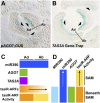Pattern formation via small RNA mobility
- PMID: 19270155
- PMCID: PMC2658522
- DOI: 10.1101/gad.1770009
Pattern formation via small RNA mobility
Abstract
MicroRNAs and trans-acting siRNAs (ta-siRNAs) have important regulatory roles in development. Unlike other developmentally important regulatory molecules, small RNAs are not known to act as mobile signals during development. Here, we show that low-abundant, conserved ta-siRNAs, termed tasiR-ARFs, move intercellularly from their defined source of biogenesis on the upper (adaxial) side of leaves to the lower (abaxial) side to create a gradient of small RNAs that patterns the abaxial determinant AUXIN RESPONSE FACTOR3. Our observations have important ramifications for the function of small RNAs and suggest they can serve as mobile, instructive signals during development.
Figures





References
-
- Adenot X., Elmayan T., Lauressergues D., Boutet S., Bouche N., Gasciolli V., Vaucheret H. DRB4-dependent TAS3 trans-acting siRNAs control leaf morphology through AGO7. Curr. Biol. 2006;16:927–932. - PubMed
-
- Allen E., Xie Z., Gustafson A., Carrington J. microRNA-directed phasing during trans-acting siRNA biogenesis in plants. Cell. 2005;121:207–221. - PubMed
Publication types
MeSH terms
Substances
Grants and funding
LinkOut - more resources
Full Text Sources
